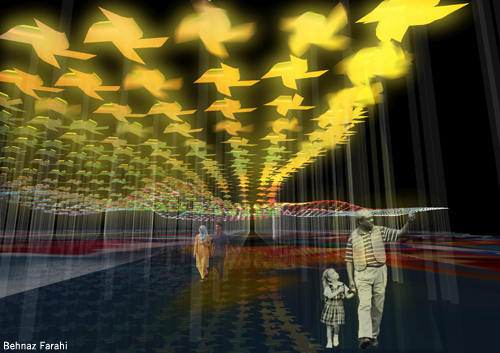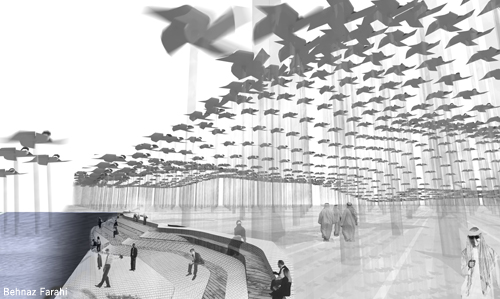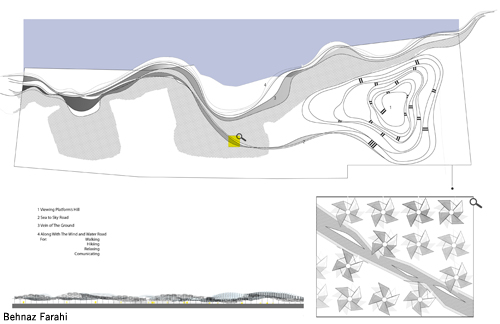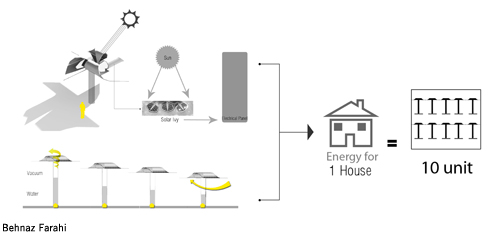Mariyan Nasirpour and Behnaz Farahi Bouzanjani
Designed for Site #2 in Abu Dhabi, between Saadiyat Island and Yas Island.

Design Submission for the 2010 Land Art Generator Initiative Design Competition
Artist’s descriptive text:
The main concept of this project is “interactivity” with environmental parameters such as wind, solar energy, and water. The land is a transformative power of wind, sun and sea. In our estimation, interaction of this kind of projects with surrounding environment would provide a panoramic insight into sustainable future cities.
Site of this project is located on a stretch of waterfront off the road that connects Yas Island to Saadiyat Island. In a sense, any intervention in this area takes a considerable attention to the natural parameters.

Rarely a context has such dynamism and interaction between natural powers. Here should be a new concept of time, one that is ever‐changing as nature. An uncertain strategy (rather than a finished composition) that responds to its context by integrating and fusing with it. Intervention must only take place to simplify actual operation of wind, water and sun. As the result of this interaction, form and function will co‐evolve spontaneously resulting in mutable surfaces. This mutable surface will affect its immediate environment while it is affected by them.
As a context, nature has subjective boundaries. Where sea ends green starts and where green ends soil starts. Our land-based interventions take a variety of forms and motions and cover part of whole site in colored pinwheels.

This land art is composed of 20,000 colorful pinwheel modules containing motions (vertically and axially) and producing energy. In each moment in a day, according to the wind direction and its intensity, this land art transforms into a spectacle of dancing pinwheels and water. Moreover, during the day, it makes shadows underneath while converting wind power to electricity, cooling its immediate surroundings. At sunset, this work of art turns into a sparkling scenery of light, like a pinwheel galaxy.
As we consider function of this land art as a clean energy generator we take into account following parameters:
- Wind flow direction changes between night and day where land meets water: Land heats up during the day more quickly than water, causing warmer and more buoyant air to rise. Cooler air over the water begins to push inland creating a breeze. The rising warm air over the land cools and moves over the sea to replace the cold air that moved inland. Land and water absorb and reflect solar energy differently due to their differing specific heat and reflectance characteristics. It takes far more energy to raise the temperature of a pound of water by one degree than a pound of earth. Landmasses typically reflect more of the sun’s energy while bodies of water tend to absorb more. This is illustrated by the fact that 12 to 30 percent reflectance is typical for meadows and fields, compared to 3 to 10 percent reflectance for water surfaces. The resulting temperature differentials ultimately lead to wind, clouds, and rain.
- This project aimed to design a portable wind turbine capable of generating 6000 kWh per year in a nominally 15 mph wind. The design is a vertical axis wind turbine with two half‐cylinder blades and an interchangeable shaft to allow for a hand crank. The drive shaft powers a generator which stores electrical energy by charging a battery while a microcontroller monitors an ammeter to control RPMs. The product can power a communication device in remote areas or in power‐loss emergencies.
- Surface of pinwheel is covered by Solar Ivy by SMIT. Solar Ivy is a solar energy‐generation and delivery system inspired by ivy. Solar Ivy’s unique visual appeal and flexibility brings a technology traditionally restricted to the any architectural surface. It has the ability to provide varying degrees of opacity to modulate heat gain, light transmission and view. In this project the leaves are made of 100% recyclable polyethylene and are available in a variety of colors and opacities which make the land art livelier. The Solar Ivy will increase the pinwheel surface friction in order to catch winds.
- This pinwheel water pump reduces atmospheric air pressure inside the pump chamber. Atmospheric pressure extends down into the sea level channels, and forces water up the pipe into the pump to balance the reduced pressure.

Related Posts
1 Comment
Add comment Cancel reply
This site uses Akismet to reduce spam. Learn how your comment data is processed.

[…] sunset, this work of art turns into a sparkling scenery of light, like a pinwheel galaxy. Source: Land Art Generator Initiative Reageer […]